Project Introduction
EigenLayer is a middleware protocol based on Ethereum, which introduces the concept of restaking, allowing Ethereum nodes to restake their staked ETH or LSD tokens into other protocols or services that require security and trust, thereby gaining double returns and governance rights. It also extends the utility of the Ethereum consensus layer to various middleware, data availability layers, sidechains, and other protocols, enabling them to enjoy Ethereum-level security at a lower cost.
1. Research Focus
1.1. Core Investment Logic
EigenLayer is an innovative and promising blockchain infrastructure service project that can provide security, scalability, and interoperability for various software modules in the Ethereum ecosystem, promoting innovation and diversity in blockchain applications.
Team: EigenLayer has a blockchain team focused on technical innovation, with 30 members, over 80% of whom are engineers. Despite being a young team, they have rich backgrounds and research experience in blockchain technology, making them a vibrant and promising blockchain team worth attention. Historically, projects built by purely technical teams have been quite successful.
Financing: EigenLayer has received high recognition and support from the capital market early in the project. EigenLayer has completed three rounds of financing, totaling over $64 million, with the latest Series A financing valuing the project at $5 billion. These data fully demonstrate EigenLayer's leading position and huge potential in blockchain security and scalability. Adequate funding also provides strong support for its subsequent development, enabling it to better serve the Ethereum ecosystem and other protocols.
Technology: EigenLayer is a disruptive technological innovation protocol that addresses technical pain points with strong real-world demand. It lowers the development threshold for other projects, bringing higher security and scalability to the Ethereum ecosystem, while enhancing Ethereum's trust network, allowing any system to leverage the security of the Ethereum pool, thereby increasing Ethereum's value and influence.
Market: EigenLayer is the first project to propose Restaking. Its restaking track currently has no obvious competitors. As an innovative concept, it has not been fully replicated or imitated by other protocols, and the market is still in its early stages with few participants.
Backed by the largest Staking market in DeFi ($20 billion TVL), the Restaking market will have numerous growth opportunities. As Staking and Restaking contribute to the expansion of the DeFi market, they will also pave the way for the growth of other DeFi submarkets, such as AMM, Lending, and Farming, forming a strong positive feedback mechanism for the market and ecosystem. Meanwhile, approximately six months after the birth of the Restaking concept, the LSD market has rapidly expanded and become a trend by the end of 2022. Restaking will not be a quickly disappearing narrative, but one of the most important and promising areas in DeFi.
As of now, EigenLayer does not have any obvious weaknesses. The project's risks mainly come from the technical and token aspects. In terms of technology, EigenLayer needs to ensure the feasibility and security of the restaking protocol to avoid situations where validators are penalized or the network is attacked. In terms of tokens, the main concerns are about the utility and value of the tokens issued and how to balance the reward distribution among validators, protocols, and users. However, these risks can be overcome as long as the EigenLayer team continues to innovate technically and build the community.
EigenLayer is undoubtedly the leader in the Restaking track, with tremendous potential and prospects, worthy of attention.
1.2. Valuation
On March 28, 2023, EigenLayer completed a $50 million Series A financing round, led by Blockchain Capital, with participation from Coinbase Ventures, Polychain Capital, Bixin Ventures, Hack VC, Electric Capital, IOSG Ventures, and others. The valuation of this financing round was $5 billion.
2. Project Overview
2.1. Basic Project Information
EigenLayer is a restaking protocol based on the ETH staking market, developed by EigenLabs in 2021. The team is mainly located in the United States. The project has not yet issued tokens, but may do so in the future. EigenLayer is currently in the first phase of the mainnet and has attracted many validators and protocol participants.
EigenLayer's business scope covers two aspects: allowing ETH stakers to restake ETH to provide security and trust for other protocols, and enabling new software modules in the ETH ecosystem to use stakers as validating nodes to enhance security and efficiency. EigenLayer supports various modules, such as consensus protocols, data availability layers, virtual machines, guardian networks, oracle networks, cross-chain bridges, threshold encryption schemes, and trusted execution environments.
Currently, Ethereum updates are progressing slowly through robust off-chain democratic governance. EigenLayer can rapidly deploy innovations on Ethereum's trusted layer, providing a testing ground for innovations on the Ethereum mainnet, avoiding the trade-off between rapid innovation and democratic governance for Ethereum.
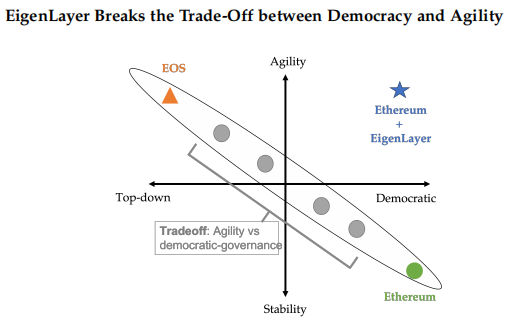
2.2. Team Situation
2.2.1. Overall Situation
EigenLayer is a restaking protocol developed by EigenLabs. EigenLabs is a laboratory focused on blockchain innovation and research, headquartered in Seattle, Washington, USA. Sreeram Kannan, the founder of EigenLabs, is an associate professor in the Department of Electrical and Computer Engineering at the University of Washington and the head of the UW Blockchain Lab. The team at EigenLabs consists of 30 experts and enthusiasts from different fields and backgrounds, primarily engineers, as well as product managers, strategic directors, and legal advisors.
2.2.2. Core Members

Sreeram Kannan is the CEO of EigenLayer. He is an associate professor in the Department of Electrical and Computer Engineering at the University of Washington, where he primarily researches information theory and its applications in communication networks, machine learning, and blockchain systems. He holds a Ph.D. in Electrical Engineering and a master's degree in Mathematics from the University of Illinois at Urbana-Champaign, and has been a postdoctoral researcher at the University of California, Berkeley, and Stanford University. He has received numerous awards and honors, such as the 2019 UW ECE Outstanding Teaching Award, the 2017 NSF CAREER Award, and the first prize in the Qualcomm Cognitive Radio Contest in 2013. He is also the head of the UW Blockchain Lab.

Robert Raynor is an engineer at EigenLayer. He is a Ph.D. student in the Department of Electrical and Computer Engineering at the University of Washington and a former Air Force officer with a background in applied physics. His current research focuses on data-driven artificial intelligence, data economics, and causal reasoning. He is also a member of the UW Blockchain Lab.

Soubhik Deb is an engineer at EigenLayer. He is a third-year Ph.D. student in the Department of Electrical and Computer Engineering at the University of Washington and a member of the UW Blockchain Lab. His goal is to design, develop, and deploy Web3.0-based systems to democratize trust, data, and control in digital platforms. He was previously a research engineer at NEC Corporation in Japan, working on 5G technology. He graduated from the Indian Institute of Technology Bombay with dual degrees in Electrical Engineering (Bachelor's and Master's).

Calvin Liu is the Chief Strategy Officer. He previously served as the Head of Strategy at Compound and is also a venture partner and angel investor who has invested in multiple blockchain projects, such as Argus Labs, Catalyst, and Liquity. He graduated from Cornell University with majors in Philosophy and Economics.
2.3. Financing Situation
According to data from Crunchbase and PitchBook, EigenLayer has completed a total of 3 rounds of financing, as follows:
On May 24, 2022, EigenLayer completed an angel round of financing, with the specific amount undisclosed, with investments from dao5, cFund, Coinbase Ventures, and others.
On August 1, 2022, EigenLayer completed a $14.5 million seed round of financing, led by Polychain Capital and Ethereal Ventures.
2023-03-28, EigenLayer completed a $50 million Series A financing round, led by Blockchain Capital, with participation from Coinbase Ventures, Polychain Capital, Bixin Ventures, Hack VC, Electric Capital, IOSG Ventures, and others. The valuation of this financing round was $5 billion.
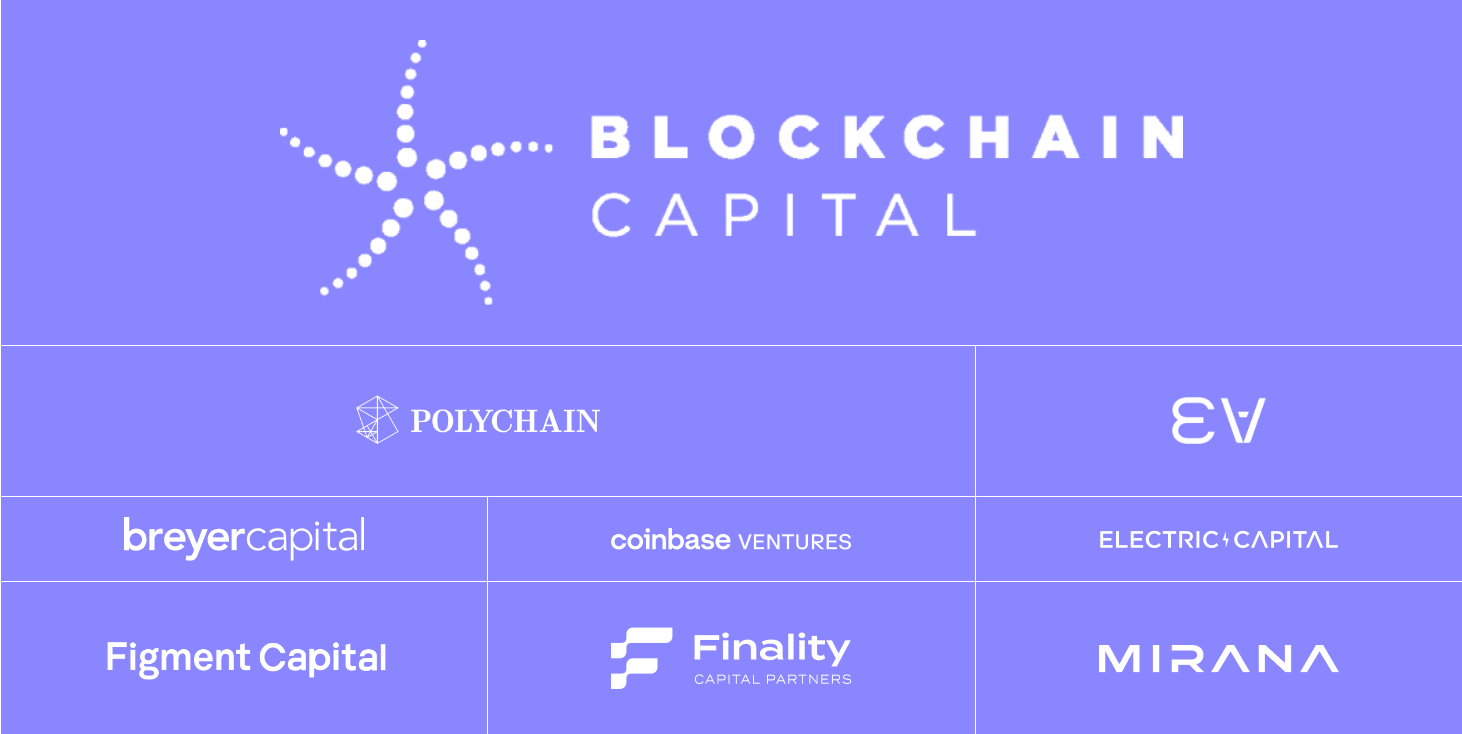
2.4. Past Development and Roadmap
2.4.1. Past Development
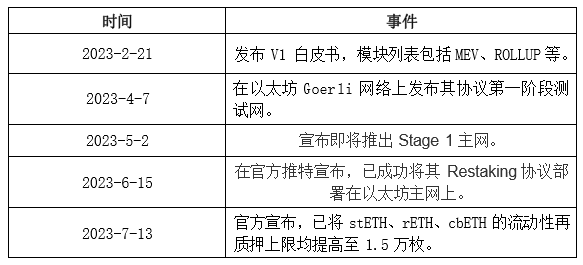
2.4.2. Development Plan and Roadmap
In the fourth quarter of 2023, EigenLayer plans to launch its second-phase protocol, introducing a free market governance mechanism that allows stakers and protocols to negotiate and reach consensus on the terms of restaking, such as fees, rewards, and slashing conditions.
Additionally, in the third quarter of 2023, the Operator testnet will be launched, followed by the launch of the Active Validation Service (AVS) testnet in the fourth quarter. The AVS mainnet is expected to be launched in the first quarter of 2024.
3. Project Analysis
3.1. Project Background
In 2009, the Bitcoin network introduced the concept of decentralized trust. The Ethereum network, which appeared in 2015, allowed the construction of various decentralized applications (dApps), but its performance and programmability were limited, requiring reliance on Layer 2 and other middleware for scalability and innovation.
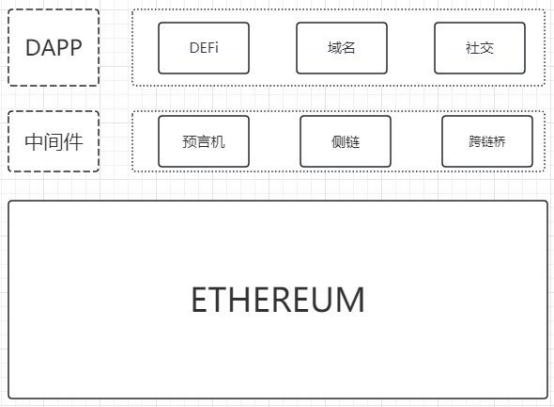
Layer 2 and other middleware and dApps cannot leverage the security of the Ethereum trust layer and need to build their own independently operated actively validated service (AVS) for their system's security, leading to two main issues:
1) Increased project threshold:
- Building a new AVS requires a significant amount of time, cost, and resources, making it difficult to achieve.
- A new AVS requires additional fees, leading to value loss and decreased user experience.
- Middleware validators need to invest funds to guard the network, resulting in a certain marginal cost. Due to the consideration of capturing token value, validators are often required to stake native tokens of the middleware, leading to uncertainty in risk exposure due to price fluctuations.
2) Security issues:
- For middleware: Since it operates independently of Ethereum itself and relies on staked native tokens to run the validator network, the security of the middleware depends on the overall value of the staked tokens. If the token price plummets, the cost of attacking the network also decreases.
- For dApps: For some dApps that rely on middleware (such as derivatives requiring oracle price feeds), their security actually depends on the trust assumptions of both Ethereum and the middleware. The trust assumption of the middleware essentially comes from trust in the distributed validator network. We have seen numerous asset loss events due to incorrect oracle price feeds.
This can lead to a serious "barrel effect," where the security of the system depends on its weakest link, and seemingly insignificant weaknesses can lead to systemic risks.
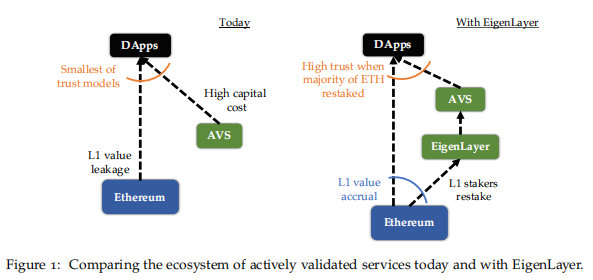
3.2. Project Principles
The idea behind EigenLayer is relatively simple, similar to shared security, attempting to elevate the security of middleware to the level of Ethereum.
This is achieved through "Restaking."
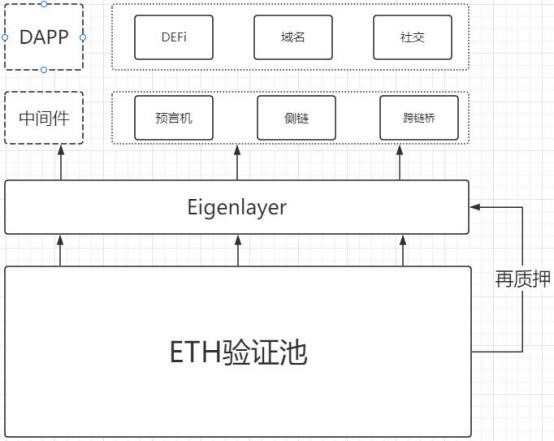
By "restaking," the Ethereum trust layer is extended, allowing developers to build their own consensus protocols and execution layers on EigenLayer without the need to build a separate trust layer. Through "trust computation" on EigenLayer, dApps can directly utilize the powerful trust layer of Ethereum without relying on middleware.
3.2.1. Slashing Mechanism Design
The security of a cryptographic network depends on the cost of attacking it, also known as the "cost of corruption." If the cost of corruption is higher than the attacker's profit, also known as the "profit from corruption," then the network is very secure.
The security of the ETH network's consensus layer is safeguarded by the potential slashing risk of staked funds, which is commonly referred to as a violent means of maintaining security.
L2 feeds transaction data back to the mainnet and audits it to inherit security, while EigenLayer allows staking "ETH value assets" to become validating nodes, borrowing the "violent means" of slashing from the mainnet to leverage its security.
3.2.2. Restaking
Previously, validators staked on the Ethereum network to earn rewards, and if they misbehaved, their staked assets would be slashed. Similarly, after restaking, they can earn staking rewards on the middleware network, but if they misbehave, their original ETH stake will be slashed. In simple terms, if validators on the Ethereum network engage in malicious behavior, they may have half of their staked 32 ETH tokens confiscated, while EigenLayer allows the confiscation of the remaining 50% on the middleware protocol.
The specific implementation of restaking is as follows: when an Ethereum validator participates in validation through EigenLayer, their fund redemption address is set to EigenLayer's smart contract, granting it the power to slash. If the node violates the application layer's rules, EigenLayer can confiscate the redeemed ETH through the slashing contract.
This slashing mechanism allows the application layer to confirm the rights and obligations of Ethereum trust layer nodes through smart contracts, providing the possibility for other applications or middleware to leverage the trust layer of Ethereum. Therefore, EigenLayer's restaking mechanism enhances security by significantly increasing the cost of malicious attacks.
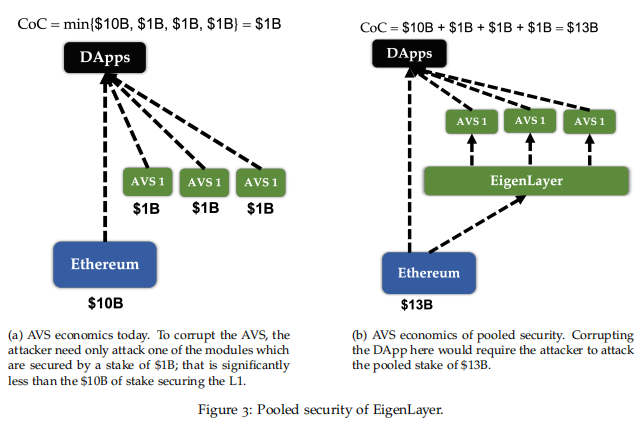
3.2.3. Trust Trading Market
EigenLayer will establish a public trust trading market, allowing Ethereum trust layer nodes and application layer protocols to determine transaction content through a free market mechanism. Nodes can decide whether to participate in a specific application's validation work to earn additional rewards based on their preferred risk-reward ratio and slashing conditions, avoiding rigid governance structures. Application layer protocols can conveniently purchase "trust" at market prices, allowing them to focus on protocol innovation and operation at the application layer, achieving a balance between their own security and performance.
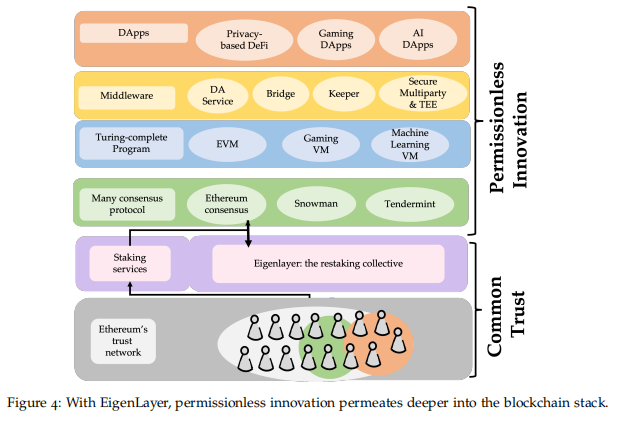
3.2.4. Support for Multiple Staking Modes
EigenLayer provides multiple staking methods similar to Lido's Liquid Staking and Superfluid Staking, where superfluid staking allows for LP token staking. Specifically:
1) Direct staking: Staking ETH directly on EigenLayer from Ethereum. 2) LSD staking: Restaking assets already staked in Lido or Rocket Pool on EigenLayer. 3) ETH LP staking: Restaking LP tokens from DeFi protocols on EigenLayer. 4) LSD LP staking: Restaking LP tokens such as Curve's stETH-ETH on EigenLayer.
Middleware can choose to retain staking requirements for its native tokens while introducing EigenLayer to continue capturing the value of its native tokens, thus avoiding a "death spiral" caused by a single token price drop.
3.2.5. Delegators
For those interested in EigenLayer but not wanting to operate as an operator, they can delegate their rights to other operator nodes, who will then stake tokens on Ethereum and distribute a portion of the rewards to these delegators. EigenLayer offers two modes:
1) Solo staking mode: Stakers provide validation services and can directly join the AVS or delegate operations to other operators while continuing to validate for Ethereum.
2) Trust Mode: Choose a trusted operator to operate. If the chosen operator fails to execute as agreed, the interests of the delegator will be penalized. In addition, restakers need to consider the fee ratio with the delegator, which is expected to create a new market. Each EigenLayer operator will establish a delegation contract on Ethereum, specifying how fees will be distributed to the delegator.
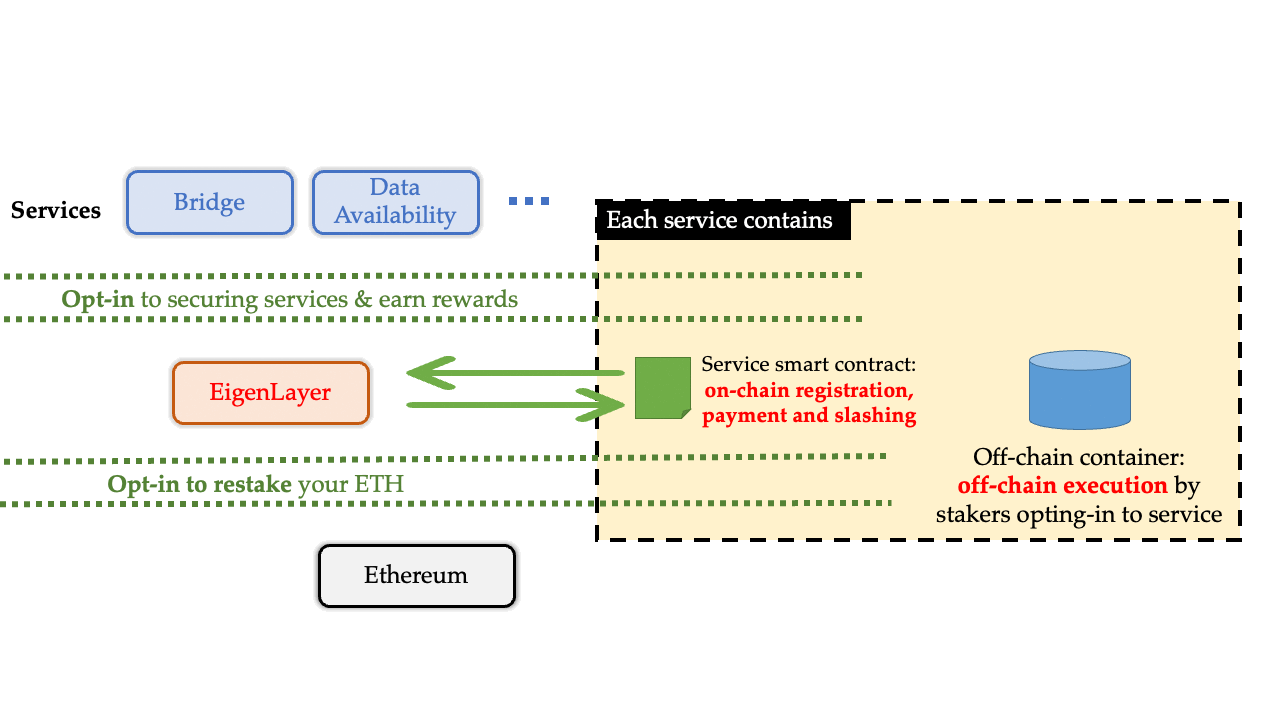
3.3. EigenLayer Flagship Product EigenDA
EigenDA is a data availability layer developed by the EigenLayer team. The data availability layer focuses solely on data storage and verification, which is crucial for network security and scalability. Other data availability layers include Celestia and Polygon Avail, which maintain security through their own token staking mechanisms. However, EigenDA has the advantage of maintaining security using the already valuable ETH tokens in the market.
The data availability of the Ethereum network is currently the biggest limiting factor for scaling rollup networks, although the introduction of EIP-4844 and sharding is expected to improve Ethereum's data availability and the scalability of rollup networks.
Advantages of EigenDA:
1) Allows EigenLayer to provide cheaper and higher bandwidth than the Ethereum mainnet. 2) Its introduction should increase the interoperability of Ethereum protocols, thereby increasing the pace of innovation. 3) More funds will flow into the Ethereum ecosystem to earn additional rewards. 4) It enhances the security of using the mainnet protocol through EigenLayer. 5) It is cheaper than other modular blockchain solutions like Celestia. 6) It increases the security of the oracle network by using EigenLayer to secure more collateral, reducing the probability of attacks on DeFi.

3.4. Project Ecosystem Applications
EigenLayer has many use cases, mainly for services that require AVS, including:
1) Cross-Chain Bridges: Protocols used to connect different blockchains can utilize EigenLayer's security to protect cross-chain asset transfers. Cross-chain bridges like Hyperlane have a low likelihood of being penalized due to their flexibility and lack of requirements for node flexibility. This provides a favorable environment for EigenLayer to operate. Other protocols include Succinct, Axelar Network, and Squid.
2) Rollup Sequencers: Protocols used to sequence Layer 2 transactions can utilize EigenLayer's security to achieve decentralization and fairness. This will decentralize and secure rollup sequencers for L2, such as Optimism and Arbitrum. Currently used centralized sequencers can review and reorder transactions, while decentralized sequencers can create transaction priority auctions like Flashbots or use fair/random sequencing, as seen in Shutter Network.
3) RPC Nodes: Protocols used to provide access to the Ethereum network can utilize EigenLayer's security to achieve truly decentralized RPC nodes. Existing solutions like Pocket Network and some centralized providers like Infura can migrate to EigenLayer. Decentralized RPC is crucial for avoiding client-side censorship.
4) Application Chains: These are independent modular blockchains created for specific applications, which can utilize EigenLayer's security for rapid and flexible innovation. Recent discussions about application chains in the web2 thought leadership have sparked a lot of interest. It seems that certain use cases (such as games, applications that can be isolated for scalability) will benefit from running independent modular application chains. Application chain deployment protocols like Atlas and Stackr Labs will be able to use EigenLayer behind the scenes to secure new application chains, with the value accumulation returning to Ethereum as the underlying security collateral.
5) Oracles: Protocols used to provide off-chain data can utilize EigenLayer's security to enhance the oracle network. Oracles are well-suited for EigenLayer because they are backed by the value of tokens like LINK. By securing the oracle network with more collateral, oracles can achieve 10 times the security, reducing the probability of attacks on DeFi.
6) Data Availability: Protocols used to provide efficient and reliable data storage and retrieval can utilize EigenLayer's security to achieve higher data bandwidth and lower costs. One of EigenLayer's flagship products, EigenDA, can increase Ethereum's data bandwidth from 80 KB per second to 15 MB, nearly 200 times. This is very useful for applications like rollups that require high data availability (DA).
7) Settlement Layers: Protocols used for settlement between different execution environments can utilize EigenLayer's security to achieve interoperability and shared liquidity in a modular blockchain ecosystem. In addition to other benefits, they allow different execution environments to settle on the same layer. The interoperability and shared liquidity effects resulting from avoiding the split of the modular ecosystem are crucial. This is another component of achieving fully decentralized rollup sequencers, as the settlement layer is where disputes are resolved.
3.5. Project Operation Process
Users who want to experience and interact with EigenLayer can operate through two methods: liquidity restaking and native restaking. The difference between the two is that the latter is suitable for staking users who operate their own validation nodes.
3.5.1. Liquidity Restaking
At the current stage, EigenLayer supports three types of liquidity staking derivative tokens: Lido stETH (stETH), Rocket Pool ETH (rETH), and Coinbase Wrapped Stakingd ETH (cbETH). For stability considerations, EigenLayer currently imposes restrictions on the protocol's TVL and the amount of single deposits. The restrictions for TVL for the three assets stETH, rETH, and cbETH are all 15,000 tokens (approximately 45,000 ETH in total), and for single deposits, users are required to deposit a maximum of 32 tokens at a time.
Before operating, users need to prepare a certain amount of stETH, rETH, or cbETH.
Taking the most commonly used stETH as an example, users can click on the stETH section on the project's official website to navigate to the corresponding restaking page. Next, users need to input the amount of stETH they want to restake, click "Next," complete authorization (which will prompt "Customize Spending Limit," select the maximum), and confirm two transactions. Upon seeing "Deposit Successful," the restaking is successful.
After returning to the homepage, users can directly track the changes in their restaked stETH rewards.
After completing the restaking, users can also withdraw their assets by selecting "Unstaking" on the specific token's restaking page. It's important to note that extracting funds from EigenLayer requires a 7-day security period, so assets can only be withdrawn after waiting at least 7 days.
3.5.2. Native Restaking
Unlike liquidity restaking, native restaking requires users to operate their own validation nodes, so the technical and financial thresholds are relatively high for users (it's also 32 ETH, but the restrictions on liquidity restaking will be lifted in the future, while this is a hard requirement for staking on the Ethereum mainnet and is unlikely to change in the future).
For this method, EigenLayer also sets a TVL limit of 9,600 ETH, but currently only 8,832 ETH has been deposited (equivalent to 276 addresses making deposits), leaving some room.
For users who are operating their own validation nodes and want to restake through this method, they can refer to the tutorial content provided in the official documentation to allocate the validator's withdrawal credentials to the EigenPods address. The specific deposit operation consists of four steps.
First, users need to enter the project's official website and connect their wallet.
Then, they need to click "Create EigenPod" to create an EigenPods. Upon successful creation, clicking "Pod Details" will provide the specific address of the EigenPods.
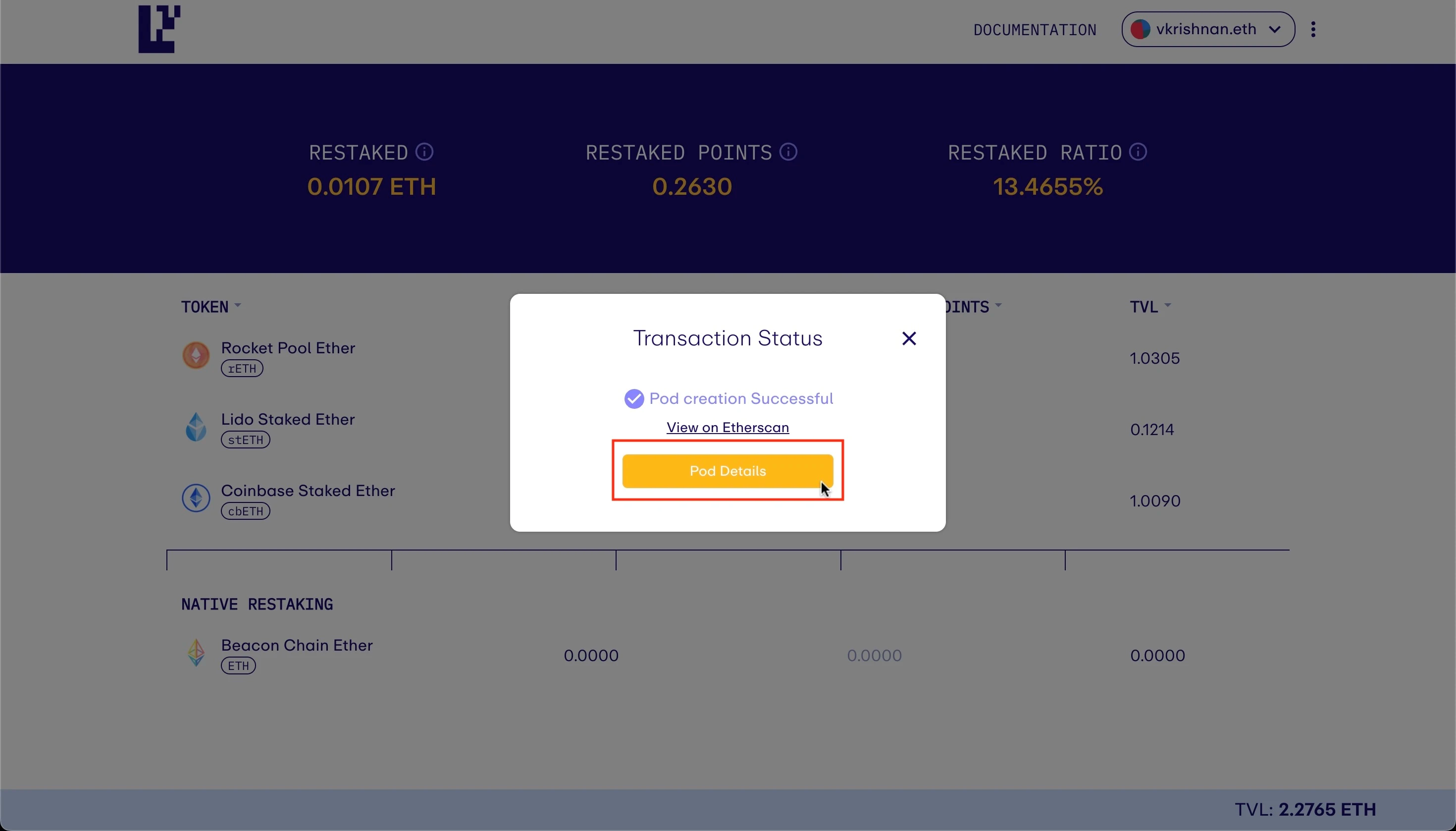
Next, the user needs to configure the withdrawal credentials from the Beacon chain to the EigenPods address (to complete this step, the Ethereum validation node must be running).
Finally, users can return to the homepage to track the real-time changes in their restaking rewards.
3.6. Project Data
3.6.1. Restaking Data
According to EigenLayer's official website data, as of August 1, 2023, EigenLayer has 10 supported modules and a total of 55,670.57 ETH has been restaked. These modules include EigenDA, The Graph, Chainlink, tBTC, API3, Gravity Bridge, Threshold ECDSA, iExec, and more. These modules cover various types such as data availability layers, oracle networks, bridges, threshold encryption schemes, trusted execution environments, demonstrating EigenLayer's wide applicability and compatibility. These modules are also among the best and most well-known projects in the blockchain field, showcasing EigenLayer's high quality and standards. This data indicates that EigenLayer has achieved a certain level of success and influence, and also shows that EigenLayer still has a lot of room for development and potential.

3.6.2. Social Media Data
As of August 1, 2023, EigenLayer has performed well on social media platforms, indicating high project popularity. Currently, EigenLayer's Discord account has attracted over 126,000 followers, with over 7,300 people online daily, making it one of the most popular channels. Additionally, there is frequent interaction on Twitter. Below are the specific data for each platform:
4. Industry Space and Potential
4.1. Track Analysis
4.1.1. Project Classification
EigenLayer is a blockchain infrastructure platform focused on the liquidity restaking field of ETH, subcategorized as the ETH restaking track.
4.1.2. Market Size
According to Staking Rewards data, as of August 1, 2023, the total value locked (TVL) in the global staking market is $12.2 trillion, with Ethereum holding the largest share at $403 billion. Other major staking networks include Solana, Cardano, Polkadot, Avalanche, Cosmos, and more.
According to DeFi Llama data, as of August 1, 2023, the total value locked (TVL) in the global staking market is $201.4 billion, with Lido holding the largest share at $147.4 billion. Lido is a liquidity staking protocol that allows users to stake ETH on the Ethereum 2.0 network and receive equivalent stETH tokens for use in the DeFi market or for restaking. Other major restaking protocols include EigenLayer, Tenet, and more.
4.1.3. Core Competitive Factors
1) Staking Scale
Asset scale refers to the total amount staked in the staking pool. We believe that an excellent staking platform should have a high asset scale to demonstrate stability and credibility.
2) Security
Protecting user assets is the most important goal for staking projects. Restaking projects need to ensure that user assets are not at risk due to smart contract vulnerabilities, improper validator behavior, or hacking attacks. Therefore, they need to employ high-level security measures and risk management mechanisms such as multi-signature, firewalls, insurance, penalties, etc.
3) Yield
Restaking projects need to provide higher yields than single staking to attract users. Therefore, they need to optimize staking strategies, income and reward distribution, and utilize compounding effects to increase user capital efficiency and returns.
4) Liquidity
Restaking projects need to address the liquidity of staked assets so that users can join or exit staking at any time, or transfer staked assets to other protocols or platforms. Therefore, they need to provide services such as liquidity staking tokens, liquidity mining, and lending markets to increase user liquidity and freedom.
5) Ecosystem
Restaking projects need to establish a strong ecosystem to support validation services for various PoS networks and protocols, thereby enhancing network security and decentralization. They also need to provide users with more choices and opportunities through collaboration and integration with other blockchain platforms, DeFi applications, Layer 2 protocols, etc.
4.1.4. Competing Projects
EigenLayer is a pioneer and innovator in the restaking field, and there are currently no clear competitors in the restaking track. As an innovative concept, it has not been fully replicated or imitated by other protocols, and the market is still in its early stages with few participants.
However, EigenLayer's restaking track may face potential competition or challenges, such as:
1) Other LSD protocols may develop their own restaking functionality, such as Lido Finance, Rocket Pool, etc.
2) Other data availability and governance service protocols may develop their own LSD functionality, such as The Graph, Aragon, etc.
3) Other Layer 2 or cross-chain protocols may develop their own security and trust networks, such as Polygon, Cosmos, etc.
Additionally, as EigenLayer mainly uses LSD as collateral, LSDFi projects in the market may also compete for LSD market share. We currently consider projects in this track as competitors.
1) LSDFI Overview
LSDFi refers to DeFi protocols built on top of liquidity staking derivative (LSD) products. By providing additional earning opportunities, LSDFi protocols allow LSD holders to utilize their assets and maximize returns. LSDFi protocols have experienced rapid growth in the past few months, benefiting from the popularity of liquidity staking. The total value locked (TVL) of the most popular LSDFi protocols has exceeded $400 million, and LSDFi's growth momentum includes the growth of ETH staking and the current low penetration rate of LSDFi. Currently, LSDFi protocols' TVL accounts for less than 3% of the market.
Some typical LSDFi protocols include Lybra Finance, Gravita Protocol, Curve Finance, Alchemix, Unsheth, Origin DeFi, Asymetrix, Pendle, and FlashStaking, among others.
2) Asset Scale Comparison
Currently, LSDFi's blue-chip collateral assets include stETH, wstETH, rETH, and cbETH, all of which are derivatives of LSD representing different LSD protocols. LSDFi's total value locked (TVL) has exceeded $400 million, demonstrating strong liquidity demand for LSD.
EigenLayer currently supports restaking assets including stETH, rETH, and cbETH, with a total value locked (TVL) of $103 million (55,709 ETH), accounting for approximately 25.75% of LSDFi's TVL. EigenLayer still has significant growth potential.
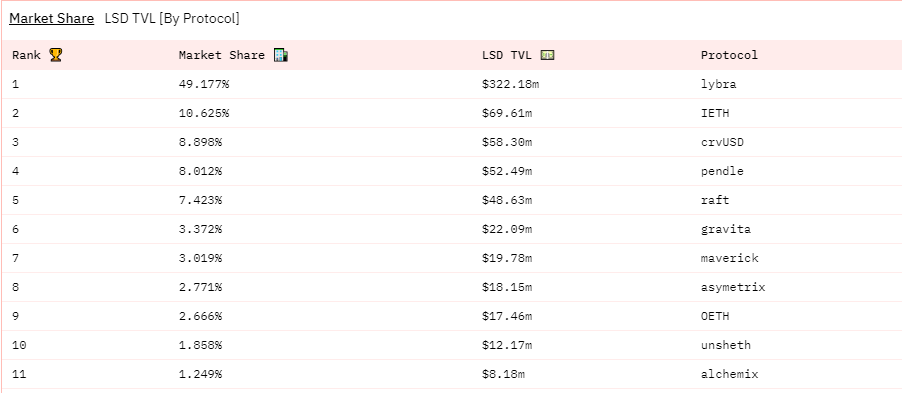
3) Similarities and Differences between EigenLayer's Restaking and LSDFI
EigenLayer and LSDFi are both innovative protocols based on LSD, allowing LSD holders to earn additional income and governance rights. The differences mainly come from the security aspect: EigenLayer allows LSD to share the trust layer of ETH, enhancing the security and availability of LSD projects, and also matches LSD holders with protocols or services needing security and trust through an open market, allowing LSD holders to customize their restaking conditions and risk preferences.
On the other hand, LSDFi's LSD projects rely on their own security, rather than sharing the trust layer of ETH.
4.2. Token Economic Model Analysis
4.2.1. Token Total Supply and Distribution
EigenLayer currently does not have its own token, but it may be issued in the future. Stay tuned.
4.2.2. Token Value Capture
Based on the analysis of the EigenLayer project, if EigenLayer issues a token, the token value may be captured through the following aspects:
① Governance: Allowing token holders to participate in decision-making regarding protocol parameters and direction in EigenLayer.
② Earnings: Allowing token holders to share in EigenLayer's protocol income and rewards, such as fees and rewards from restaking protocols or services.
③ Collateral: Allowing token holders to use EigenLayer's token as collateral to participate in the security and trust of other protocols or services.
4.2.3. Core Token Demanders
Based on the analysis of the EigenLayer project, the core demanders of EigenLayer's token may include the following categories:
- LSD holders: They can restake their LSD to other protocols or services through EigenLayer to earn double income and governance rights.
- Protocols or services needing security and trust: They can utilize the trust layer of ETH through EigenLayer to reduce their security costs and risks.
5. Preliminary Valuation
5.1. Core Issues
At which stage of operation is the project? Is it in the mature stage or in the early to mid-stage of development?
EigenLayer is a relatively new project, founded in 2021 and completed its seed round financing in May 2022, followed by a Series A financing in February 2023. EigenLayer has currently launched the first phase of its mainnet, and the next phase will introduce Operators who will be responsible for executing validation tasks for Active Verification Services (AVS) built on the EigenLayer protocol, supporting 10 modules. The market size and potential for EigenLayer are significant, but there are also challenges and risks such as technical difficulty, ecosystem compatibility, and market competitiveness. Continuous innovation, ecosystem development, and marketing efforts are necessary for EigenLayer to achieve its project vision and goals. Therefore, EigenLayer is still in the early stages of development and has significant room for growth and potential.
Does the project have reliable competitive advantages? Where do these competitive advantages come from?
Innovation: EigenLayer introduces a new cryptographic economic security primitive called restaking, allowing stakers in the Ethereum consensus layer to choose to validate other modules and earn additional income and influence. This mechanism is unprecedented in the blockchain field and represents a future trend and direction.
Technical Advantage: EigenLayer utilizes stakers in the Ethereum consensus layer as validators, providing a high level of decentralization and security, avoiding the trust risk of centralized service providers or native tokens.
Flexibility: EigenLayer provides a free market mechanism for stakers and modules to choose and pay based on risk and reward, improving efficiency and flexibility, and avoiding rigid governance structures.
Scalability: EigenLayer supports various types and levels of blockchain technology, including consensus protocols, data availability layers, virtual machines, guardian networks, oracle networks, bridges, threshold encryption schemes, trusted execution environments, etc. These technologies are among the most important and active in the blockchain field, with great potential and prospects. EigenLayer can provide foundational services such as security, scalability, and interoperability for these technologies, promoting innovation and diversity in blockchain applications.
Influence: EigenLayer expands Ethereum's trust network, allowing any system to absorb Ethereum pool security, increasing Ethereum's value and influence. EigenLayer has also attracted some of the most outstanding and well-known projects in the blockchain industry as supported modules, such as The Graph, Chainlink, tBTC, API3, Gravity Bridge, etc. EigenLayer has also gained support and recognition from some of the most authoritative and influential institutions and individuals in the blockchain industry, such as Blockchain Capital, Coinbase Ventures, Spencer Bogart, etc.
What are the main variable factors in the project's operation? Are these factors easy to quantify and measure?
Restaking Volume: The volume of ETH or liquidity tokens restaked through EigenLayer reflects the trust and participation of stakers in EigenLayer, as well as EigenLayer's market share and revenue scale. Higher restaking volume indicates greater support and competitiveness for EigenLayer. This factor is easy to quantify and measure and can be obtained from the EigenLayer official website or other data platforms.
Supported Module Count: The number of software modules available through EigenLayer for obtaining validation nodes reflects the demand and selection level of modules for EigenLayer, as well as EigenLayer's ecosystem compatibility and service scope. A higher number of supported modules indicates greater ability to meet the needs and expectations of modules, as well as greater scalability and diversity for EigenLayer. This factor is easy to quantify and measure and can be obtained from the EigenLayer official website or other data platforms.
Validation Service Quality: The effectiveness and level of validation services provided by EigenLayer for modules reflect EigenLayer's technical capabilities and user experience, as well as its value capture and creation. Higher validation service quality indicates greater ability to ensure the security, scalability, and interoperability of modules, as well as the provision of high-quality services and experiences. While not as easy to quantify and measure, validation service quality can be evaluated using indicators or standards such as the number of validation nodes, distribution, stability, response speed, accuracy, fee rates, reward rates, penalty rates, etc.
What is the project's management and governance approach?
EigenLayer uses a reputation-based committee for governance, consisting of prominent individuals from the Ethereum and EigenLayer communities. This committee is responsible for upgrading EigenLayer contracts, reviewing and vetoing penalty events, and allowing new AVS to enter the penalty review process.
AVS can use this committee to assure restakers in EigenLayer that they will not be subject to malicious or erroneous penalties. Additionally, AVS developers can conduct practical testing on the codebase related to AVS. Once mature and trusted by restakers, AVS can stop using the committee as a backup. When creating AVS on EigenLayer, the committee may need to conduct security audits and other due diligence, including checking the system requirements for validators to serve AVS.
6. SWOT Analysis
6.1. Strengths
Triple Revenue: Through EigenLayer's restaking solution, liquidity tokens can capture revenue not only in the Ethereum system but also in other cross-chain bridges, oracle networks, etc. If lsdETH LP staking is introduced, it can achieve triple revenue: staking Ethereum income, token rewards for validator nodes, and LP staking rewards in DeFi.
Increased Market Efficiency: Unlocking the liquidity of LSD and LP tokens provides more asset choices and combinations for the DeFi industry. By renting Ethereum security on the open market through EigenLayer, new protocols can save costs on internal guidance and maintenance.
Enhanced Network Security: Increasing the security of networks using liquidity staking allows more assets to be staked, thereby increasing the value and resistance to attacks of the network, promoting Ethereum's economic security and providing security for application protocols, creating a positive feedback loop.
Reduced Project Entry Barriers: New blockchain projects need to establish their own trust layer to ensure the security of data and funds. This requires a lot of time and money and increases the difficulty of launching. Using Ethereum's beacon chain staking as a trust layer can reduce costs and barriers, improving core functionality and user experience.
6.2. Weaknesses
Asset Loss Risk: If nodes or networks are attacked, forked, or behave improperly, restakers' assets may be penalized, resulting in partial or permanent loss.
Asset Bubble Risk: If there are too many tokens or stablecoins in the market, it may lead to inflated asset values or deviation from their true value, increasing market instability and investor confusion.
Value Capture Risk: If the security and incentives provided by EigenLayer are not sufficient to attract protocols and validators, it may lead to loss of protocol sovereignty, reduced value of collaborative projects, or slow ecosystem development.
Unstaking Period Risk: If unstaking ETH requires a waiting period before unlocking, users may face liquidity and price fluctuation risks.
Trust Leverage Risk from Restaking: In the open trust trading market, trust layer nodes can earn additional income by providing validation services for different protocols through restaking. When trust layer funds are used to provide validation services for applications/middleware layers with significant accumulated value in order to earn more income, it may lead to extreme leverage in trust, where the reward for disruption exceeds the cost of disruption, reducing the economic security of the trust layer.
6.3. Opportunities
Pioneer and Innovator: Restaking is a unique concept with no direct competitors in the track, not yet fully replicated or imitated by other protocols, and the market is still in its early stages with few participants.
Market Share: Currently, the largest market in the DeFi industry is Staking, with a total value of approximately $20 billion (TVL). Especially as many blockchain platforms are still under development, the scale of the cryptocurrency market continues to expand. Therefore, the Restaking market will have numerous growth opportunities.
6.4. Threats
Tokenomics Issues: If users can earn income by restaking ETH without needing to use native tokens of other protocols, EigenLayer's native token may lack value and demand.
Reward Distribution Issues: If the protocol cannot balance incentives for existing participants and restaking participants when adopting EigenLayer, it may lead to unfair token distribution and low user participation.
Security Event Risk: If a large portion of staked ETH in the Ethereum network is restaked, any security vulnerabilities in a protocol may lead to a large amount of ETH being penalized, affecting the security of the Ethereum network.
Technical Risk: EigenLayer involves various types and levels of blockchain technology, which may have technical flaws or vulnerabilities leading to system crashes or attacks. These technical risks may result in asset or trust loss for restakers and modules, impacting the project's reputation and development. EigenLayer needs to reduce technical risks through rigorous code audits, testnet deployments, and security rewards.
7. References
https://www.eigenlayer.xyz/about#mission EigenLayer Project Official Website
https://docs.eigenlayer.xyz/overview/readme/protocol-features EigenLayer Project Documentation
- EigenLayer Official Twitter
- EigenLayer Official Forum
- EigenLayer Official Blog
- [EigenLayer Whitepaper](https://2039955362-files.gitbook.io/~/files/v0/b/gitbook-x-prod.appsp ot.com/o/spaces%2FPy2Kmkwju3mPSo9jrKKt%2Fuploads%2F9tExk4U2OdiRKGEsUW qW%2FEigenLayer_WhitePaper.pdf?alt=media&token=c20ac4bd-badd-4826-9fb 6-492923741c9e)
- In-depth Analysis of EigenLayer Whitepaper: Scaling of the Consensus Layer, Important Development Direction of LSD
Investment Risk and Disclaimer
The content analysis provided in this report is for reference only and does not constitute any form of investment advice or decision-making basis. We strongly advise against making any investment decisions based on this report to avoid potential risks. WJB and the report authors are not responsible for the investment results based on this report.
The preparation time of this report is as of the date shown, and subsequent changes in the market or economic conditions may result in changes to the content. The graphics, charts, and other visual aids in the report are for reference only and cannot be used as a basis for making investment decisions. Any graphics, charts, or other visual aids in the report cannot cover all the factors and variables needed to make such decisions. Please note that WJB does not assist anyone in making specific investment decisions.
Some of the discussions in this report may be assumptions and other forward-looking views by WJB about future expectations. However, these assumptions and views are subject to known and unknown risks and uncertainties, which may result in significant differences between actual results, performance, or events and the stated views and assumptions.
All speculations, forecasts, and estimates in this report are based on certain assumptions and are speculative in nature. These forward-looking statements may prove to be incorrect and may be affected by incorrect assumptions or known or unknown risks, uncertainties, and other factors, most of which are beyond control. It is expected that some or all of these forward-looking assumptions will not be realized, or there will be significant differences from actual results.
Copyright Information
This report is copyrighted by WJB. Without written permission, no organization or individual may infringe on WJB's copyright through reprinting, copying, quoting, or redistributing in any form.
免责声明:本文章仅代表作者个人观点,不代表本平台的立场和观点。本文章仅供信息分享,不构成对任何人的任何投资建议。用户与作者之间的任何争议,与本平台无关。如网页中刊载的文章或图片涉及侵权,请提供相关的权利证明和身份证明发送邮件到support@aicoin.com,本平台相关工作人员将会进行核查。




